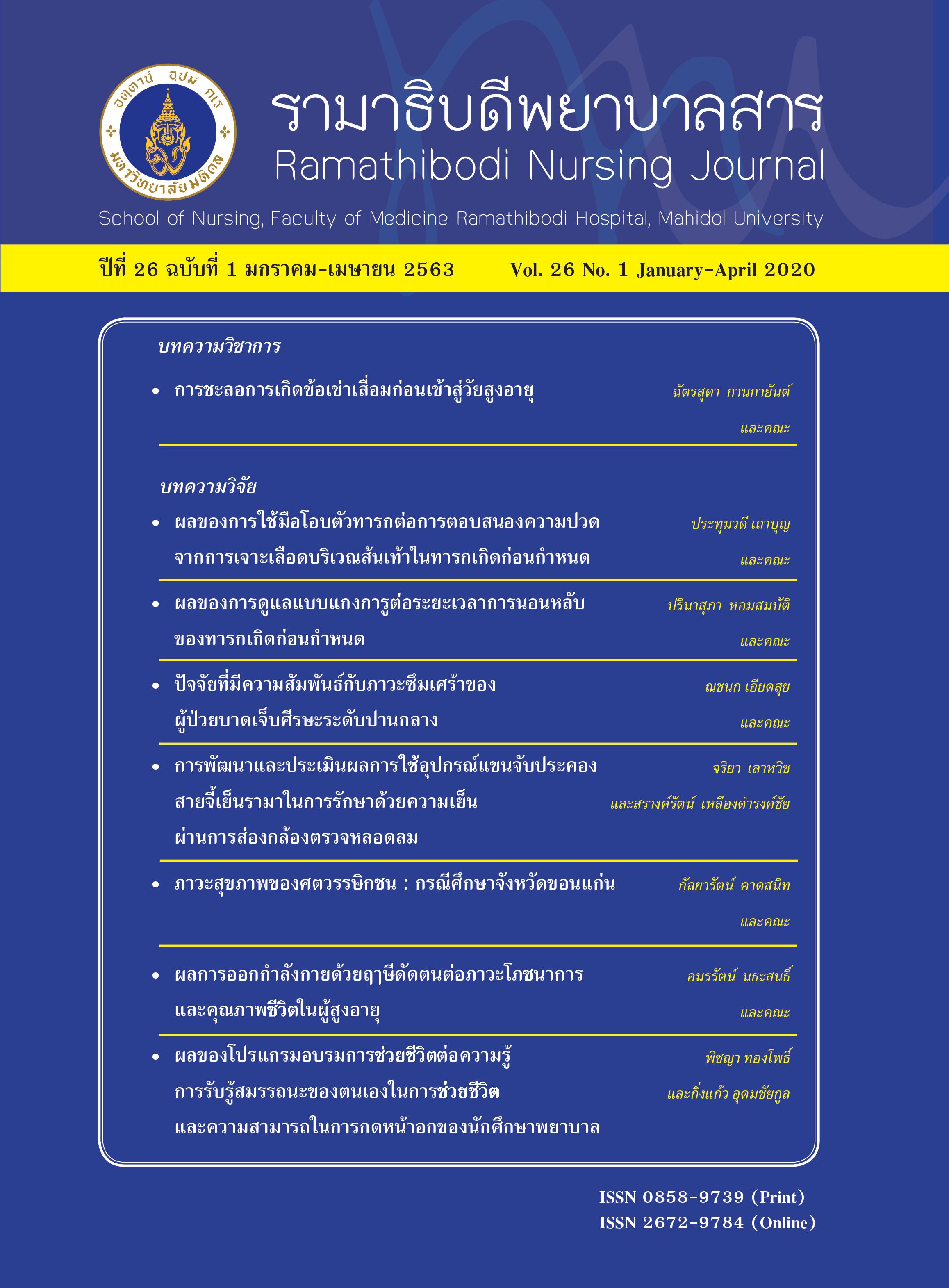Development and Evaluation of Rama chest Cryo Arm in the Bronchoscopic Cryotherapy
Main Article Content
Abstract
Holding and stabilizing the cryoprobe is important for bronchoscopic cryotherapy in combination with endoscopic procedures successfully and precisely. This study aimed to develop and evaluate the use of the “Rama Chest Cryo Arm” device for bronchoscopic cryotherapy. Purposive sampling was used to recruit the 16 participants using this procedure at a tertiary hospital. The sample consisted of 3 nurse bronchoscopists
and 13 bronchoscopists. Research instruments included 1) the device “Rama-Chest Cryo Arm” 2) the data collection questionnaires, and 3) the evaluation form for using the device. The data were analyzed with descriptive statistics. The results showed that the mean score of total four aspects of the sample on the “Rama Chest Cryo Arm” device was on the highest level. The value of the “Rama Chest Cryo Arm” device was rated as the highest, followed by the usability, safety from contamination, and purpose relevancy, respectively. Therefore, the “Rama Chest Cryo Arm” device could be used as a choice at hospitals providing the bronchoscopic cryotherapy procedure.
Article Details
บทความ ข้อมูล เนื้อหา รูปภาพ ฯลฯ ที่ได้รับการตีพิมพ์ในรามาธิบดีพยาบาลสาร ถือเป็นลิขสิทธิ์ของวารสาร หากบุคคลหรือหน่วยงานใดต้องการนำทั้งหมดหรือส่วนหนึ่งส่วนใดไปเผยแพร่หรือเพื่อกระทำการใด ใด จะต้องได้รับอนุญาตเป็นลายลักษณ์อักษรจากรามาธิบดีพยาบาลสารก่อนเท่านั้น
References
Chadha M, Kulshrestha M, Biyani A. Anaesthesia for bronchoscopy. Indian J Anaesth. 2015; 59(9):565-73.
doi : 10.4103/0019-5049.16 5851.
Bronchoscope Statistical Report. Faculty of Medicine Ramathibodi Hospital; 2016. (in Thai)
Meghan IC, Thomas John P. The use of cryotherapy via bronchoscopy for removal of obstructing tracheobronchial thrombi. Int J Crit Illn Inj Sci. 2015;5(3):215–6. doi:10.4103/2229-5151.165009
David M. Anthony R, Andrew R. Bronchoscopic Cryotherapy. Clinical applications of the cryoprobe,
cryospray, and cryoadhesion. Ann Am Thorac Soc.2016;13(8):1405-15.
Homasson JP, Renault P, Angebault M, Bonniot JP, Bell NJ. Bronchoscopic cryotherapy for airway strictures caused by tumors. Chest. 1986;90:159–64.
Mathur PN, Wolf KM, Busk MF, Briete WM, Datzman M. Fiberoptic bronchoscopic cryotherapy in the
management of tracheobronchial obstruction.Chest. 1996;110:718–23.
David MD, Anthony RL, Andrew RH. Bronchoscopic cryotherapy: clinical applications of the cryoprobe,
cryospray, and cryoadhesion. Ann Am Thorac Soc.2016;13(4):1405-15.
Martin J. The role of the nurse bronchoscopist. Nurs Times. 2003;99(41):14-20.
Tracey MW. Design and development research: a model validation case. Educ. Technol. Res. Dev. 2009;57(4):
-71. doi: 10.1007/s11423-007-9075-0.
Martin JL, Norris BJ, Murphy E, Crowe JA. Medical device development: the challenge for ergonomics. Appl
Ergon. 2008;39(3):271-83. doi: 10.1016/j.apergo.2007.10.002.
Castner J, Sullivan SS, Titus AH, Klingman KJ.Strengthening the role of nurses in medical device development. J Prof Nurs. 2016;32(4): 300-5. doi:10.1016/j.profnurs.2016.01.002.
Lang AR, Martin JL, Sharples S, Crowe JA. The effect of design on the usability and real world effectiveness of
medical devices: a case study with adolescent users. Appl Ergon. 2013;44(5):799-810. doi: 10.1016/j.
apergo.2013.02.001.
Bergmann JHM, Noble A, Thompson M. Why is designing for developing countries more challenging? modelling the product design domain for medical devices. Procedia Manuf. 2015;3:5693-8. doi:10.1016/j.promfg.2015.07.792.
Pongsukwetchakul T, Chiannilkulchai N. Development the Clip lock for strap sterile operating microscope drape and evaluation of its effectiveness. Ramathibodi Nursing Journal. 2018;24(2):163-77. (in Thai)
Kobayashi K, Imagama S, Kato D, Ando K, Hida T, Ito K, et al. Collaboration with an infection control team for
patients with infection after spine surgery. Am J Infect Control. 2017;45(7):767-70. doi: 10.1016/j. ajic.2017.01.013.
Blandford A, Furniss D, Vincent C. Patient safety and interactive medical devices: realigning work as imagined
and work as done. Clin Risk. 2014;27(5):107-10. doi:10.1177/1356262214556550.


